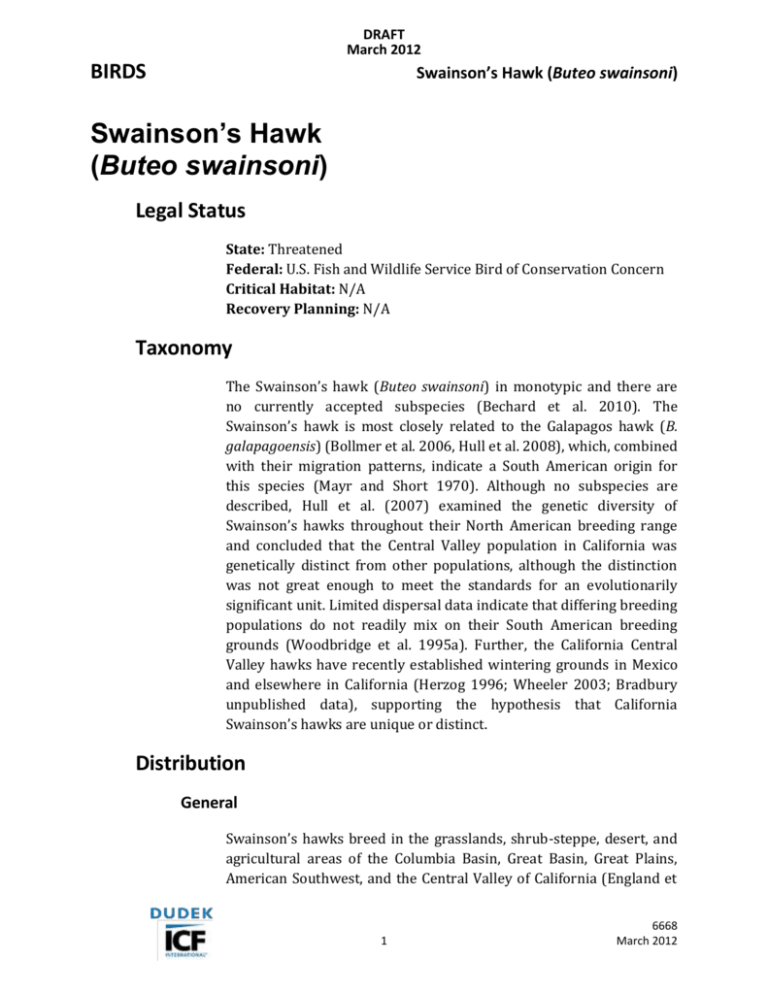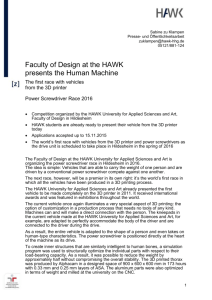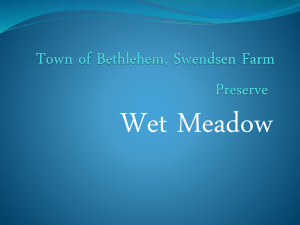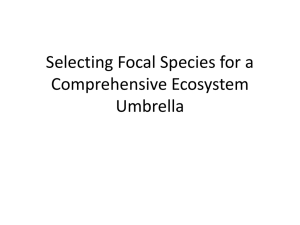Swainson_Hawk_DRECP
advertisement

DRAFT March 2012 BIRDS Swainson’s Hawk (Buteo swainsoni) Swainson’s Hawk (Buteo swainsoni) Legal Status State: Threatened Federal: U.S. Fish and Wildlife Service Bird of Conservation Concern Critical Habitat: N/A Recovery Planning: N/A Taxonomy The Swainson’s hawk (Buteo swainsoni) in monotypic and there are no currently accepted subspecies (Bechard et al. 2010). The Swainson’s hawk is most closely related to the Galapagos hawk (B. galapagoensis) (Bollmer et al. 2006, Hull et al. 2008), which, combined with their migration patterns, indicate a South American origin for this species (Mayr and Short 1970). Although no subspecies are described, Hull et al. (2007) examined the genetic diversity of Swainson’s hawks throughout their North American breeding range and concluded that the Central Valley population in California was genetically distinct from other populations, although the distinction was not great enough to meet the standards for an evolutionarily significant unit. Limited dispersal data indicate that differing breeding populations do not readily mix on their South American breeding grounds (Woodbridge et al. 1995a). Further, the California Central Valley hawks have recently established wintering grounds in Mexico and elsewhere in California (Herzog 1996; Wheeler 2003; Bradbury unpublished data), supporting the hypothesis that California Swainson’s hawks are unique or distinct. Distribution General Swainson’s hawks breed in the grasslands, shrub-steppe, desert, and agricultural areas of the Columbia Basin, Great Basin, Great Plains, American Southwest, and the Central Valley of California (England et 1 6668 March 2012 DRAFT March 2012 BIRDS Swainson’s Hawk (Buteo swainsoni) al. 1997) (Figure SP-B15). In California, most breeding occurs in the Central Valley between Modesto and Sacramento (Bloom 1980), and approximately 95% of the breeding pairs now occur in the Central Valley (CDFG 2007). Smaller breeding populations are also found in the Great Basin region of extreme northeastern California, in the Owens River Valley, and in nearby Fish Lake Valley on the Nevada border. Remnant (or recolonizing) populations in Southern California are found in the Antelope Valley and Mojave National Preserve regions of the western Mojave Desert. Historically, Swainson’s hawks nested throughout the California lowlands, including coastal valleys where they no longer occur today (Bloom 1980). Breeding has been reported near Cima Dome and Lanfair Valley in San Bernardino County, at Oasis Ranch in Mono County, and near Lancaster in Los Angeles County. The species formerly bred in Joshua tree woodland habitat near Victorville and Adelanto in San Bernardino County (England and Laudenslayer, cited in Latting and Rowlings 1995). Migrating Swainson’s hawks pass through Anza Borrego State Park and Morongo Valley in spring. In fall, hawks also migrate through the eastern Colorado Desert and along the Colorado River. While most birds winter in South America, there are small, isolated wintering populations in the Sacramento-San Joaquin River Delta in California and in southern Florida (Natural Resource Consultants and Western EcoSystems Technology, Inc. 2011). Distribution and Occurrence within the Plan Area Historical Historically, Swainson’s hawks were much more common in the Southern California deserts than they are today (Sharp 1902; Bloom 1980). Bloom (1980) estimated that the Mojave/Colorado Deserts population has declined by 95% in the previous century. Current nesting territories in Southern California may represent recolonizations (Woodbridge 1998). There are three historical (i.e., pre-1990) occurrence records in the Plan Area and an additional three records with an unknown observation date (CDFG 2012; Dudek 2011). These occurrences are located east of Lancaster, in the eastern 2 6668 March 2012 DRAFT March 2012 BIRDS Swainson’s Hawk (Buteo swainsoni) portion of the Mojave National Preserve, and north of Fremont Wash and east of State Highway 395 (Figure SP-B15). Two historical nest territories in the Lanfair Valley within the Mojave National Preserve had last reported activity in the early 1980s. Recent Recent Swainson’s hawk breeding populations inside the DRECP Plan Area have occurred in the Antelope Valley, Owens River Valley, and at the Mojave National Preserve. Approximately ten pairs nest over a relatively wide area in Antelope Valley (Bloom 2011). Several pairs nest in upper Owens River Valley, just north (outside) of the DRECP Plan Area. However, an isolated Owens River Valley nesting territory (active in 2003) does occur inside the DRECP Plan Area at Haiwee Reservoir (Bloom 2011). There are 34 recent occurrences in the Plan Area (CDFG 2012; Dudek 2011). The vast majority of these occurrences are clustered in the western Mojave region along the base of the San Gabriel and Tehachapi Mountain ranges and in the Antelope Valley. Scattered occurrences are located in the Fremont Valley, the Ridgecrest/China Lake Naval Air Weapons Station, and near Haiwee Reservoir. There is a single occurrence south of the Salton Sea (Figure SP-B15). Natural History Habitat Requirements Swainson’s hawks are primarily a grassland bird but they are also found in sparse shrubland and open woodlands (England et al. 1997). In Central California Swainson’s hawks are primarily associated with grain and hay croplands that mimic native grasslands with respect to prey density and availability (Estep 1989, Babcock 1995). They generally nest in isolated trees, narrow bands of vegetation, or along riparian corridors in grassland, shrubland, and agricultural landscapes. Historically, Swainson’s hawks nested in small willows or aspens remnant from wildfire or bison grazing, or in riparian areas (especially in California). Within the DRECP Plan Area, Joshua trees (Yucca brevifolia) and non-native ornamental trees or trees planted as windbreaks also function as nest sites (CEC and CDFG 2010; Table 1). 3 6668 March 2012 DRAFT March 2012 BIRDS Swainson’s Hawk (Buteo swainsoni) Most Swainson’s hawks winter in the pampas (grasslands) of South America, but they are adapting to agricultural lands there, as they have on their North American breeding grounds (Woodbridge et al. 1995a). Foraging habitat includes dry land and irrigated pasture, alfalfa, fallow fields, low-growing row or field crops, new orchards, and cereal grain crops. In the Plan Area, in addition to alfalfa fields in the Antelope Valley, Swainson’s hawks may also forage in grasslands, Joshua tree woodlands, and other desert scrub habitats that support a suitable prey base. Table 1. Habitat Associations for Swainson’s Hawks in the Plan Area Land Cover Type Cropland Land Cover Use Foraging; nesting Habitat Designation Primary Joshua tree woodlands Nesting Secondary Desert grasslands Foraging Primary Habitat Parameters Adapted to foraging in agricultural fields, but not in crops that grow higher than native vegetation. Nests in isolated trees in riparian vegetation Historically nested in Joshua tree woodlands, now also in ornamental roadside trees and wind row trees (see above) Forages in open landscapes with low and/or widely spaced vegetation See above Desert Foraging Secondary scrub __________________ Sources: Bechard 1982; CEC and CDFG 2010; Estep 1989 Supporting Information Direct observations Direct observations Direct observations Direct observations Foraging Requirements In North America, breeding Swainson’s hawks prey chiefly upon small rodents such as young ground squirrels (Spermophilis spp.), pocket gophers (Thomomys spp.), deer mice (Peromyscus spp.), and voles (Microtus spp.). Voles are especially important to Central California 4 6668 March 2012 DRAFT March 2012 BIRDS Swainson’s Hawk (Buteo swainsoni) hawks. Their breeding season diet also includes birds, snakes, and insects (especially grasshoppers and crickets) (Snyder and Wiley 1976; Fitzner 1980; Bednarz 1988; Estep 1989). Non-breeding birds in North America and wintering birds in South America feed almost exclusively on insects, especially grasshoppers (Synder and Wiley 1976; Johnson et al. 1987; Sarasola and Negro 2005). Swainson’s hawks in the Antelope Valley forage primarily on Botta’s pocket gopher (Thomomys bottae) in agricultural areas and on a wider variety of prey in desert scrub and grassland habitats (CEC and CDFG 2010). Reproduction Swainson’s hawks arrive on the breeding grounds in March-April (March in Central California) (Table 2) and begin a week-long nest building phase 1 to 2 weeks after arrival (Fitzner 1980). The egglaying through fledging period lasts about 73 days per nest, but can last 110 days for the local population (Olendorff 1973). Adjacent pairs can be out of sync by 25 days (Woodbridge 1987). Average clutch size is 2 or 3 eggs (Olendorff 1973; Fitzner 1980; Bechard 1983; Bednarz and Hoffman 1986) and an average of about 2 young are fledged per successful nest (England et al. 1997), although this value can drop to an average of less than 1 during years of low prey availability (i.e., not all nests are successful) (Bechard 1983). Young generally fledge midJuly to mid-August at an average age of 43 days (Olendorff 1973, Fitzner 1980, Woodbridge 1987). 5 6668 March 2012 DRAFT March 2012 BIRDS Swainson’s Hawk (Buteo swainsoni) Dec Nov Oct Sep Aug July June May April March Feb Jan Table 2. Key Seasonal Periods for Swainson’s Hawks Breeding Migration Wintering ________________ Notes: Central Valley (California) Swainson’s hawks arrive a month earlier on breeding grounds than other populations, possibly because they winter in central Mexico (Bradbury unpublished) rather than Argentina. _________________ Sources: Wheeler 2003, England et al. 2010 Spatial Behavior Spatial behaviors by Swainson’s hawk include migration patterns, breeding home range use, and natal dispersal. Migratory movements occur annually between North American breeding grounds and wintering areas primarily located in South America, although some Swainson’s hawks use wintering grounds in California and Mexico (Fuller et al. 1998, England et al. 1997, Wheeler 2003, Bradbury unpublished data). Immature birds and post-breeding adults begin forming migration flocks in August and September, and begin the fall migration in September. Birds migrating to South America leave North America by October and arrive in Argentina in November (England et al. 1997). The return migration begins lateFebruary and early March in Argentina (England et al. 1997), with birds arriving in California from early March (Central Valley) through April (other California populations). Fuller et al. (1998) tracked 27 Swainson’s hawks on their 1996 and 1997 southbound migrations and recorded a mean cumulative travel distance of over 13,500 kilometers (8,370 miles). Local movements of California hawks are primarily confined to home ranges, which vary greatly in size (from 69 to 8,718 ha) among populations. Home ranges of less than 1,000 hectares occur in habitats dominated by natural vegetation types (Fitzner 1978; Bechard 1982; Woodbridge 1991) while home ranges greater than 6 6668 March 2012 DRAFT March 2012 BIRDS Swainson’s Hawk (Buteo swainsoni) 2,500 hectares are found in fragmented agricultural landscapes (Estep 1989, Babcock 1995). Natal dispersal also varies greatly among populations. Central California hawks disperse only a few kilometers (mean of 3.5 kilometers; Estep 1989), while northeastern California hawks disperse farther (mean of 9 kilometers) (Woodbridge et al. 1995b). But in greater contrast, juvenile Swainson’s hawks in Saskatchewan apparently disperse to distances exceeding 200 kilometers (Houston and Schmutz 1995). Table 3. Movement Distances for Swainson’s Hawks Type Home Range Dispersal Range Migration Distance/Area 69–8,718 ha 3.5–9 km Location of Study Washington, Oregon California Citation Fitzner 1978; Bechard; 1989; Woodbridge 1991 Estep 1989; Woodbridge et al. 1995b Fuller et al. 1998 Mean of 13,504 United States km southward, 11,592 km northward Notes: ha = hectare; km = kilometer. Home range depends on habitat type. Ecological Relationships Predator–prey relationships are critical for Swainson’s hawk. Reduction of rodent populations due to conversion of native grassland to cropland has resulted in declines of Swainson’s hawks in some locations in North America, especially Central California (Risebrough et al. 1989). Also, because of their dependence on insect prey, especially grasshoppers on the wintering grounds, Swainson’s hawks are highly susceptible to secondary poisoning from insecticides (Woodbridge et al. 1995a). Swainson’s hawks occasionally lose nestlings or fledglings to great horned owl (Bubo virginianus) predation (Fitzner 1978; Littlefield et al. 1984; Woodbridge 1991), and Swainson’s hawks themselves have preyed on burrowing owl (Athene cunicularia) fledglings (Clayton and Schmutz 1999). Interspecific competition and territoriality occurs between Swainson’s hawk and sympatric buteos (e.g., red-tailed hawks 7 6668 March 2012 DRAFT March 2012 BIRDS Swainson’s Hawk (Buteo swainsoni) [Buteo jamaicensis]) over control of nest sites, although Swainson’s hawks appear to dominate in most such encounters (Janes 1984). Population Status and Trends Global: Secure (NatureServe 2010) State: Imperiled (NatureServe 2010) Within Plan Area: Imperiled (CEC and CDFG 2010) In California the Swainson’s hawk is vulnerable to extirpation due to its very restricted range (primarily the Central Valley), few populations, steep population declines, and loss of habitat. Bloom (1980) concluded that the California Swainson’s hawk population had declined 90% since 1900 when Sharp (1902) considered the species abundant. Much of this decline occurred in Southern California, where the species was once considered abundant in coastal valleys (Sharp 1902) but is now completely absent. Based on its large decline, Swainson’s hawk was listed as a state-threatened species in 1983. Later inventories estimated populations of 800 hawks in 1988 and 1,000 hawks in 1994 (CDFG 2007). The CDFG initiated an inventory of Swainson’s hawk breeding pairs in California in 2005 and 2006 (CDFG 2007a). Based on a randomized sampling, the CDFG estimated a breeding population of 1,912 pairs (95% confidence interval of 1,471 to 2,353 pairs) in 2005 and 2,251 breeding pairs (95% confidence interval of 1,811 to 2,690 pairs) in 2006. The combined estimate for 2005–2006 is 2,081 pairs (95% confidence interval of 1,770 to 2,393 pairs). Approximately 94% of the breeding pairs now occur in the Central Valley. Swainson’s hawk populations in the Mojave and Colorado Desert portions of the DRECP Plan Area have also declined severely in the past century. Bloom (1980) estimated that this region once supported 270–1,080 pairs, but abundance has since declined as much as 95%. Today, a few nesting pairs occur in Antelope Valley at the extreme western edge of the Mojave Desert and primarily forage in the alfalfa fields and other agricultural areas in the region (CEC and CDFG 2010; Bloom 2011). They also forage in grassland, Joshua tree woodlands, desert scrub habitats (CEC and CDFG 2010). A small breeding population has been identified at Mojave National Preserve near the Nevada border (CNDDB 2011). The Owens Valley population is 8 6668 March 2012 DRAFT March 2012 BIRDS Swainson’s Hawk (Buteo swainsoni) principally found immediately north of the DRECP boundary, but there is one record inside the Plan Area south of Owens Lake, and in the future the Owens Lake population may further expand into the Plan Area. These small, isolated populations could be remnants of the much larger historical population, or they could be recent colonists, in which case the Southern California population would be growing. Threats and Environmental Stressors The decline of Swainson’s hawks in California has been attributed to riparian habitat loss from agricultural activities in the Central Valley (Bloom 1980, England et al. 1995), urbanization in the coastal valleys (Bloom 1980), a contracting range of Joshua trees and riparian habitats in the Mojave Desert (Bloom 1980). It was estimated that by the mid-1980s, approximately 93% of riparian habitat in the San Joaquin Valley and 73% of riparian habitat in the Sacramento Valley had been lost since the 1850s (CDFG 1994). Chronic and acute pesticide poisoning also affects the Swainson’s hawk (Goldstein et al. 1996, Risebrough et al. 1989). Pesticide use on South American wintering grounds threatens all North American populations. South American birds have died from ingesting pesticides targeting grasshoppers (Woodbridge et al 1995a; Goldstein et al. 1996). Goldstein et al. (1996) estimated that 4,100 Swainson’s hawks died in one year, 1996, from acute pesticide poisoning in Argentina. Wildfires, lowering of water tables, and flood control also continue to threaten riparian and woodland nesting habitat in California. Off-road vehicle activity and shooting can also disrupt nesting, although the latter is not as important a factor as it once was. Intraspecific competition or aggression with other raptors and common ravens (Corvus corax) has been suggested as a stressor elsewhere in the western United States (Janes 1987; Littlefield et al. 1984). Conservation and Management Activities There are no active conservation efforts specific to Swainson’s hawks in the DRECP Plan Area. The CEC and CDFG have developed protocols to avoid and minimize impacts of renewable energy projects on Swainson’s hawk in the Antelope Valley (CEC and CDFG 2010). These protocols also include methods for conducting pre-project surveys 9 6668 March 2012 DRAFT March 2012 BIRDS Swainson’s Hawk (Buteo swainsoni) within a 5-mile radius of a proposed project. If active nests are found in proximity to a project a Monitoring and Mitigation Plan is required. Potential avoidance and minimization measures include maintaining sufficient foraging and fledgling area; a 0.5-mile buffer zone during construction between project activities and an active nest; avoidance of nest trees to extent feasible; and provision of habitat management lands to offset habitat losses within 0.5 mile of an active nest. The overarching objective of these protocols is to enable renewable energy projects to comply with CEQA and CESA regulations regarding the Swainson’s hawk. Further, the Los Angeles Audubon Society is focusing conservation efforts towards the approximately ten pairs of Swainson’s hawks inhabiting the Antelope Valley. This effort has been largely confined to encouraging the City of Lancaster to consider Swainson’s hawk conservation in any future solar energy permitting. The Desert Bird Conservation Plan, jointly developed by the California Partners in Flight (CalPIF) and Point Reyes Bird Observatory (PRBO) Conservation Science, is non-regulatory document designed to assist land-managers in improving habitat condition for desert birds of the Mojave and Colorado Deserts (the portion of the Sonoran Desert in the Plan Area). Although Swainson’s hawks are not a focal species in the Desert Bird Conservation Plan, it does promote restoration of Joshua tree habitats that are important to nesting Swainson’s hawks. Statewide, Swainson’s hawks are a focus of the CalPIF/PRBO Riparian Bird Conservation Plan recognizing the importance of riparian trees (e.g., Fremont cottonwood [Populus fremontii]) as nesting habitat for California Swainson’s hawks. The Friends of the Swainson’s Hawk, a grassroots organization founded in 1994, recently developed a conservation strategy for California Swainson’s hawk populations. Although this strategy focuses on Central Valley populations, it does provide a framework for conservation and management of Swainson’s hawks statewide. The CDFG also published a staff report in 1994 regarding recommended mitigation for Swainson’s hawk that includes recommendations for mitigation for impacts within a 10-mile radius 10 6668 March 2012 DRAFT March 2012 BIRDS Swainson’s Hawk (Buteo swainsoni) of an active nest site; the 10-mile radius reflects the flight distance between an active nest and foraging habitat (CDFG 1994). Data Characterization The current status of nesting territories in the Owens River Valley and the Mojave National Preserve within the DRECP Plan Area is unknown. It is likely, however, that most all Swainson’s hawk concerns relative to DRECP are confined to the Antelope Valley. As described above, survey protocols and avoidance and minimization measures designed to protect this population have been developed (CEC and CDFG 2010). Management and Monitoring Considerations Within the DRECP Plan Area, management and monitoring considerations include maintaining suitable nesting habitat and proximity to reliable food sources. Currently Swainson’s hawks rely heavily on the alfalfa and other agricultural fields for prey (primarily gophers), but they may also forage in desert scrub and Joshua tree woodland habitats within flight distances from active nests (CEC and CDFG 2010; Bloom 2011). Potential disturbance of active nest sites from human activities is also a concern. As described above in Conservation and Management Activities, the CEC and CDFG (2010) have issued protocols for surveying and guideline measures for avoiding or minimizing impacts from DRECP projects in Antelope Valley, the only location where Swainson’s hawk conflicts are most likely to occur in the DRECP Plan Areas. Predicted Species Distribution in Plan Area Two separate models for breeding and migrating/foraging were developed for Swainson’s hawk. There are 60,091 acres of modeled suitable breeding habitat for Swainson’s hawk in the Plan Area. Modeled suitable breeding habitat occurs in the Antelope watershed and includes agriculture and grassland and riparian vegetation communities. There are 30,280 acres of modeled suitable migrating/foraging habitat for Swainson’s hawk in the Plan Area. Modeled suitable migrating/foraging habitat occurs in the Antelope, 11 6668 March 2012 DRAFT March 2012 BIRDS Swainson’s Hawk (Buteo swainsoni) Homer, Fremont, Indian Wells, and Owens watersheds. Modeled habitat includes agriculture and scrub, grassland, and riparian communities. Appendix C includes specific model parameters and figures showing the modeled suitable habitat in the Plan Area. Appendix C provides a summary of the methodology used to model DRECP Covered Species with Maxent. For the Swainson’s hawk, 24 occurrence points were used to train the Maxent model and eight occurrence points were used to test the model’s performance. Overall, the Maxent model has fair statistical support. The small number of occurrence samples across the widespread species range limits the model’s predictive ability throughout the Plan Area. Based on a natural break in the distribution of the probability of occurrence that Maxent estimates, all 100-meter grid cells with greater than 0.210 probability of occurrence were defined as Swainson’s hawk habitat. The Maxent model predicts 486,810 acres of Swainson’s hawk habitat, compared with 60,091 acres predicted by the expert model. The Maxent model predicts Swainson’s hawk habitat throughout the West Mojave and Imperial Valley, although to a lesser extent. The Maxent model predicts habitat in the vicinity of occurrence data, but there is also predicted habitat in areas with no occurrence data in the West Mojave and Imperial Valley. Similar to the Maxent model, but in a much narrower range, the expert model predicts habitat for the western West Mojave around occurrence data, but does not encompass all occurrence data in the Plan Area. Model Summary Primary Habitat—Nesting Habitat [Describe primary habitat.] Secondary Habitat—Foraging [Describe secondary habitat.] Model Results [Summarize model results.] 12 6668 March 2012 DRAFT March 2012 BIRDS Swainson’s Hawk (Buteo swainsoni) Literature Cited Babcock, K. W. 1995. “Home range and habitat use of breeding Swainson’s hawks in the Sacramento Valley of California.” Journal of Raptor Research 29(3):193–197. Bechard, M. J., C. S. Houston, J. H. Sarasola and A. S. England. 2010. “Swainson's Hawk (Buteo swainsoni).” The Birds of North America Online (A. Poole, Ed.). Ithaca: Cornell Lab of Ornithology; Retrieved from the Birds of North America Online: http://bna.birds.cornell.edu/bna/species/265. Bechard, M. J. 1982. “Effect of vegetative cover on foraging site selection by Swainson's Hawk.” Condor 84:153-159. Bechard, M. J. 1983. “Food supply and the occurrence of brood reduction in Swainson's Hawk.” Wilson Bulletin 95:233–242. Bednarz, J. C. 1988. “A comparative study of the breeding ecology of Harris' and Swainson's hawks in southeastern New Mexico.” Condor 90:311–323. Bednarz, J. C. and S. W. Hoffman. 1986. “The status of breeding Swainson's Hawks in southeastern New Mexico.” Pages 253259 in Proceedings of the Southwest raptor management symposium. Vol. 11 (Glinski, R. L., B. G. Pendelton, M. B. Moss, M N. LeFranc, Jr., B. A. Millsap, and S. W. Hoffman, Eds.) Natl. Wildl. Fed. Sci. Tech. Ser. no. Bloom, P. 2011. Conference call with Pete Bloom and Greg Green (ICF International). February 16, 2011. Bloom, P. H. 1980. The status of the Swainson's Hawk in California, 1979. Nongame Wildlife Investigations, Job II-8.0. Wildlife Management Branch, California Department of Fish and Game, Sacramento, California. Bollmer, J. L., R. T. Kimball, N. K. Whiteman, J. H. Sarasola, and P. G. Parker. 2006. “Phylogeography of the Galapagos hawk (Buteo 13 6668 March 2012 DRAFT March 2012 BIRDS Swainson’s Hawk (Buteo swainsoni) galapagoensis): A recent arrival to the Galapagos Islands.” Molecular Phylogenetics and Evolution 39(1):237–247. Bradbury, M. Unpublished data on migratory patterns and wintering range of the Central Valley Swainson’s hawk. CDFG (California Department of Fish and Game). 2011. “Buteo swainsoni.” Element Occurrence Query. California Natural Diversity Database (CNDDB). Rarefind Version 4.0 (Commercial Subscription). Sacramento, California: CDFG, Biogeographic Data Branch. Accessed February 2012. http://www.dfg.ca.gov/biogeodata/cnddb/mapsanddata.asp. CDFG. 2007. California Swainson’s Hawk Inventory: 2005–2006. U.C. Davis Wildlife Health Center and Department of Fish and Game Resource Assessment Program. P0485902. CDFG. 1994. Staff Report Regarding Mitigation for Impacts to Swainson’s Hawk (Buteo swainsonii) in the Central Valley California. California Energy Commission and California Department of Fish and Game. 2010. Swainson’s Hawk Survey Protocols, Impact Avoidance, and Minimization Measures for Renewable Energy Projects in the Antelope Valley of Los Angeles and Kern Counties, California. June. Clayton, K. M. and J. K. Schmutz. 1999. “Is the decline of Burrowing Owls Speotyto cunicularia in prairie Canada linked to changes in Great Plains ecosystems?” Bird Conservation International 9(2):163–185. Dudek. 2011. “Species Occurrences–Buteo swainsoni.” DRECP Species Occurrence Database. Updated November 2011. England, A. S., J. A. Estep, and W. R. Holt. 1995. “Nest-site selection and reproductive performance of urban nesting Swainson’s hawks in the Central Valley of California.” Journal of Raptor Research 29(3):186–197. 14 6668 March 2012 DRAFT March 2012 BIRDS Swainson’s Hawk (Buteo swainsoni) England, A. S., M. J. Bechard, and C. S. Houston. 1997. “Swainson’s hawk (Buteo swainsoni)” in A. Poole and F. Gill (eds.), The Birds of North America, No. 265. The Academy of Natural Sciences, Philadelphia, PA, and The American Ornithologists’ Union. Washington, D.C. Estep, J. A. 1989. Biology, movements, and habitat relationships of the Swainson’s hawk in the Central Valley of California. California Department of Fish and Game, Wildlife Management Division. Sacramento, California. Fitzner, R. E. 1978. Behavioral ecology of the Swainson's Hawk (Buteo swainsoni) in southeastern Washington. PhD Thesis. Washington State Univ. Pullman. Fitzner, R. A. 1980. Behavioral ecology of the Swainson’s hawk (Buteo swainsoni) in Washington. Report prepared for the U.S. Department of Energy’s Pacific Northwest Laboratory. Richland, Washington. 65 pages. Fuller, M. R., W. S. Seegar, and L. S. Schueck. 1998. “Routes and travel rates of migrating Peregrine Falcons Falco peregrinus and Swainson's Hawks Buteo swainsoni in the Western Hemisphere.” Journal of Avian Biology 29(4):433–440. Goldstein, M. I., B. Woodbridge, M. E. Zaccagnini, and S. B. Canavelli. 1996. “An assessment of mortality of Swainson's Hawks on wintering grounds in Argentina.” Journal of Raptor Research 30:106–107. Goldstein, M. I., T. E. Lacher, B. Woodbridge, M. J. Bechard, S. B. Canavelli, M. E. Zaccagnini, G. P. Cobb, E. J. Scollon, R. Tribolet, and M. J. Hopper. 1999. “Monocrotophos-induced mass mortality of Swainson's Hawks in Argentina, 1995–96.” Ecotoxicology 8(3):201–214. Herzog, S. K. 1996. “Wintering Swainson's Hawks in California's Sacramento-San Joaquin River Delta.” Condor 98:876-879. Houston, C. S. and J. K. Schmutz. 1995. “Swainson's Hawk banding in North America to 1992.” North American Bird Bander 20:120–127. 15 6668 March 2012 DRAFT March 2012 BIRDS Swainson’s Hawk (Buteo swainsoni) Hull, J. M., R. Anderson, M. Bradbury, J. A. Estep, and H. B. Ernest. 2008. “Population structure and genetic diversity in Swainson's Hawks (Buteo swainsoni): implications for conservation.” Conservation Genetics 9(2):305–316. Hull, J. M., W. Savage, J. P. Smith, N. Murphy, L. Cullen, A. C. Hutchins, and H. B. Ernest. 2007. “Hybridization among buteos: Swainson's Hawks (Buteo swainsoni) x Red-tailed Hawks (Buteo jamaicensis).” Wilson Journal of Ornithology 119(4):579–584. Janes, S. W. 1984. “Influences of territory composition and interspecific competition on Red-tailed Hawk reproductive success.” Ecology 65:862–870. Janes, S. W. 1987. “Status and decline of Swainson's Hawks in Oregon: the role of habitat and interspecific competition.” Oregon Birds 13:165–179. Johnson, C. G., L. A. Nickerson, and M. J. Bechard. 1987. “Grasshopper consumption and summer flocks of nonbreeding Swainson's Hawks.” Condor 89:676–678. Latting, J., and P.G. Rowlands. 1995. The California Desert: An Introduction to Natural Resources and Man’s Impact. June Latting Books. Littlefield, C. D., S. P. Thompson, and B. D. Ehlers. 1984. “History and present status of Swainson's Hawks in southeast Oregon.” Journal of Raptor Research 18:1–5. Mayr, E. and L. L. Short. 1970. “Species taxa of North American birds: a contribution to comparative systematics.” Publications of the Nuttall Ornithological Club, No. 9. Natural Resource Consultants and Western EcoSystems Technology, Inc. 2011. A Biological Constraints Analysis of the approximately 4,191.7-acre Wildflower Green Energy Farm Site Located in Los Angeles County, California. Prepared for Los Angeles County. June 14, 2011. Accessed February 23, 2011. 16 6668 March 2012 DRAFT March 2012 BIRDS Swainson’s Hawk (Buteo swainsoni) http://planning.lacounty.gov/assets/upl/case/ r2010-00256_bca.pdf. Olendorff, R. R. 1973. The Ecology of the Nesting Birds of Prey of Northeastern Colorado. Technical Report No. 211. USIBP Grassland Biome. Risebrough, R. W., R. W. Schlorff, P. H. Bloom, and E. E. Littrell. 1989. “Investigations of the decline of Swainson's Hawk populations in California.” Journal of Raptor Research 23:63–71. Sarasola, J. H. and J. J. Negro. 2005. “Hunting success of wintering Swainson's Hawks: environmental effects on timing and choice of foraging method.” Canadian Journal of Zoology-Revue Canadienne De Zoologie 83(10):1353–1359. Sharp, C. S. 1902. “Nesting of Swainson Hawk.” Condor 4:116–118. Snyder, N. F. R. and J. W. Wiley. 1976. Sexual Size Dimorphism in Hawks and Owls of North America. Ornithological Monograph No. 20. Schmutz, J. K. 1987. “The effect of agriculture on ferruginous and Swainson’s hawks.” Journal of Range Management 40(5): 438–440. Wheeler, B. K. 2003. Raptors of Western North America. Princeton University Press, Princeton, New Jersey. Woodbridge, B. 1987. Biology and management of Swainson's Hawks in the Butte Valley, California. U.S. Forest Serv., Klamath National Forest, Goosenest Ranger District, Mt. Hebron, CA. Woodbridge, B. 1991. Habitat selection by nesting Swainson's Hawks: a hierarchical approach. Master's Thesis. Oregon State University, Corvallis. Woodbridge, B., K. K. Finley, and S. T. Seager. 1995a. “An investigation of the Swainson's Hawk in Argentina.” Journal of Raptor Research 29:202–204. Woodbridge, B., K. K. Finley, and P. H. Bloom. 1995b. “Reproductive performance, age structure, and natal dispersal of Swainson's 17 6668 March 2012 DRAFT March 2012 BIRDS Swainson’s Hawk (Buteo swainsoni) Hawks in the Butte Valley, California.” Journal of Raptor Research 29:187–192. Woodbridge, B. 1998. California Partners in Flight Riparian Bird Conservation Plan for the Swainson’s Hawk. Point Reyes Bird Observatory Website. 16 pp. 18 6668 March 2012





